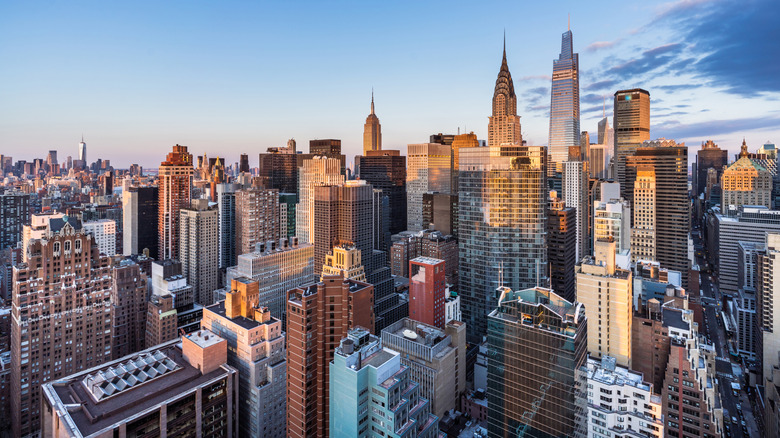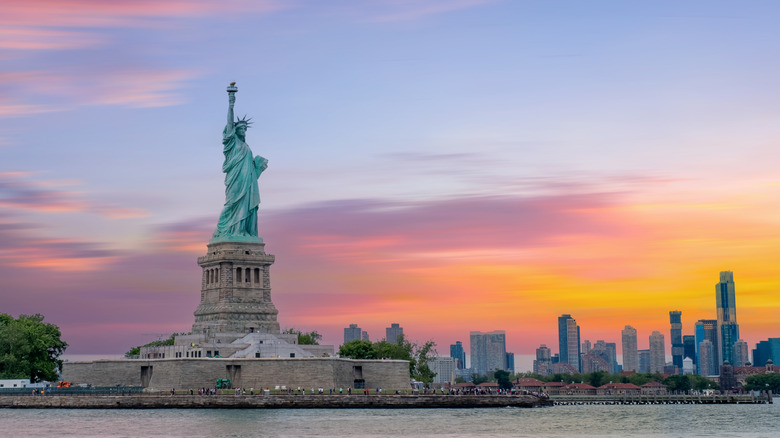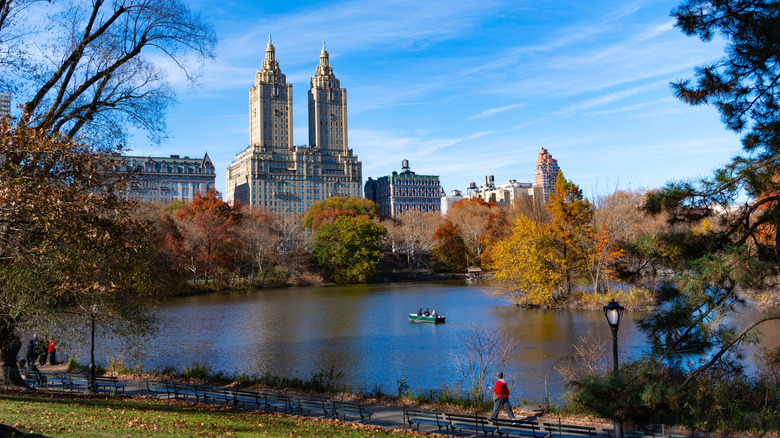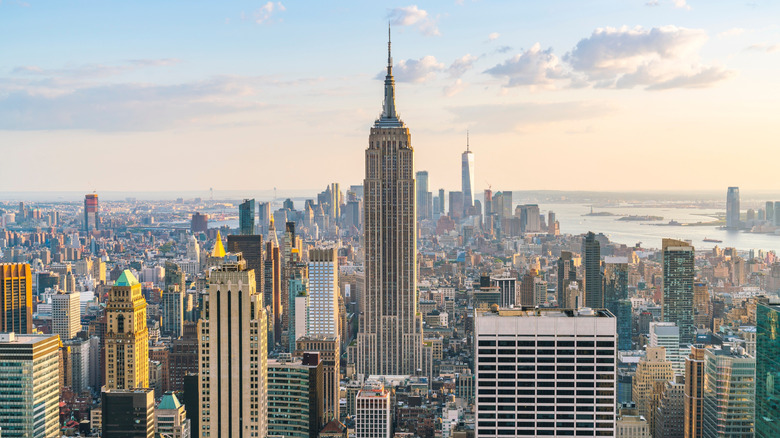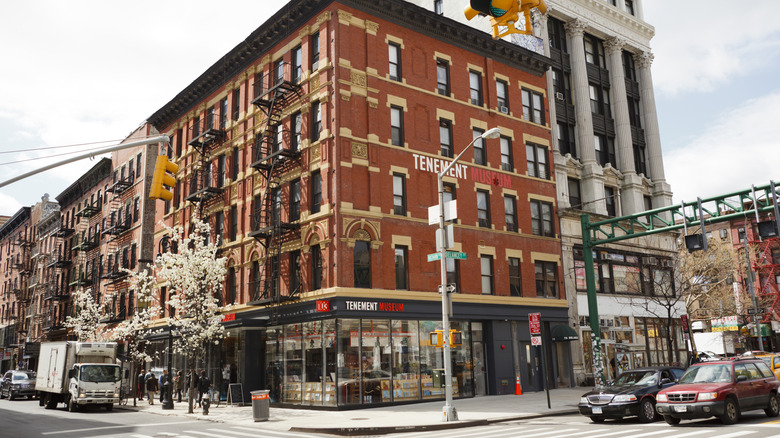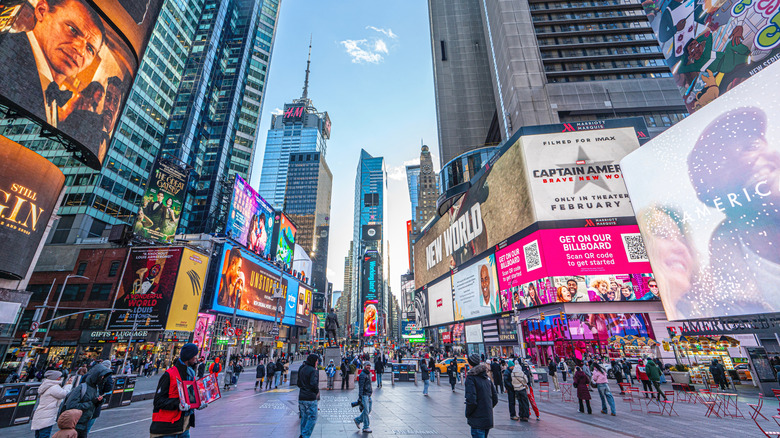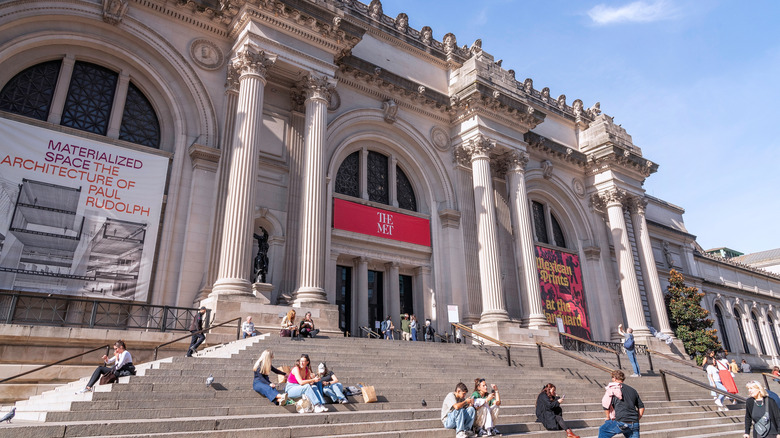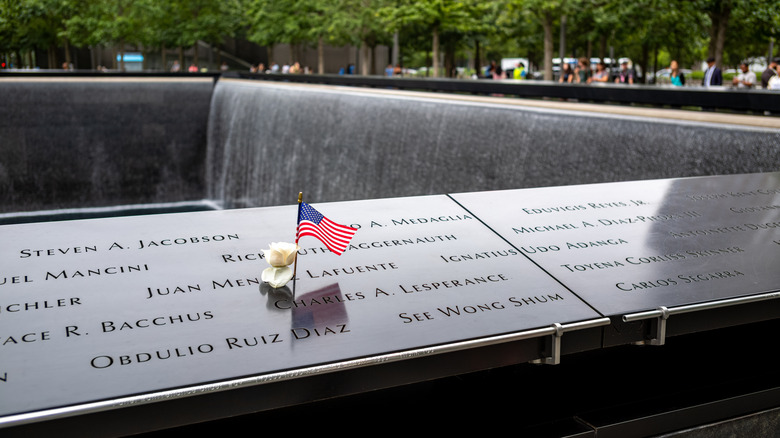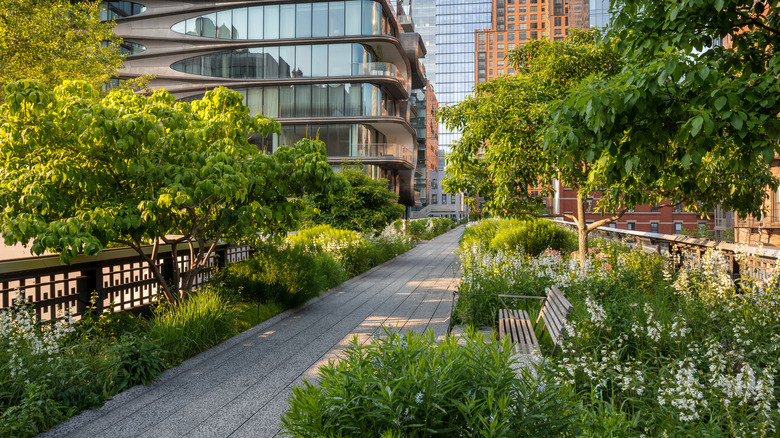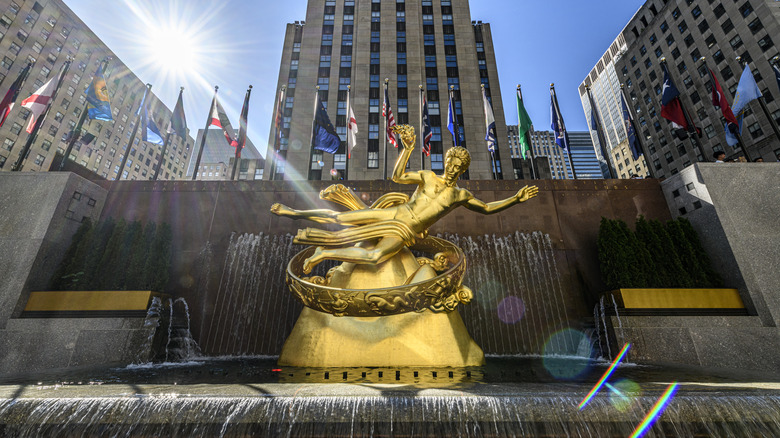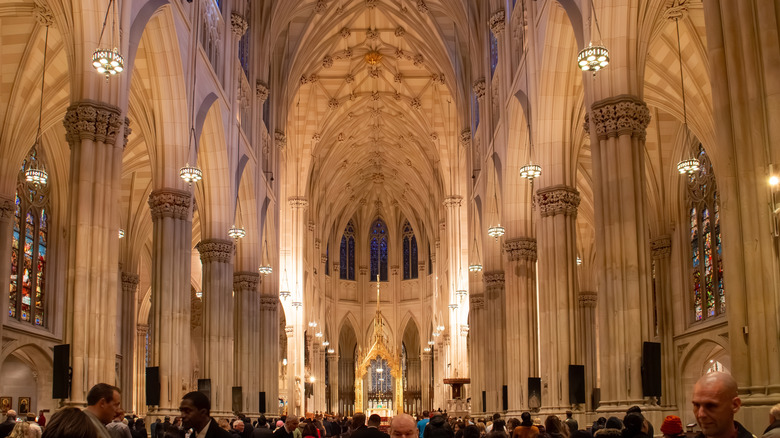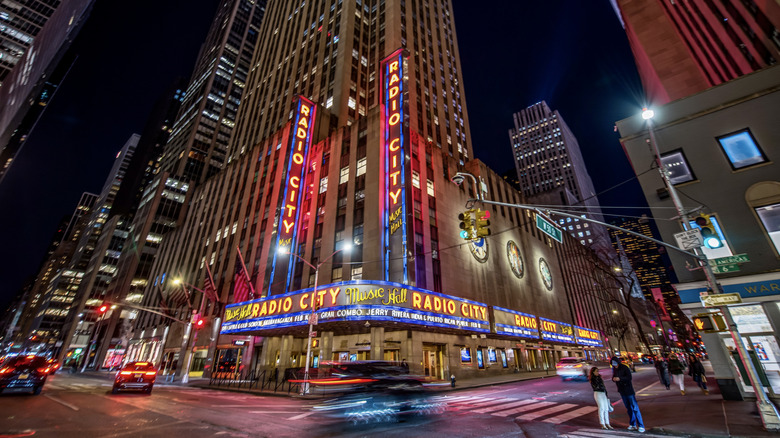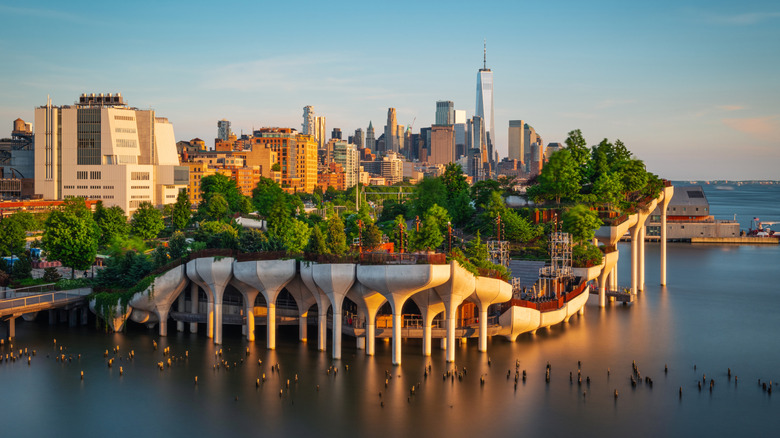New York City's Top 12 Places To Check Out For First-Time Visitors
From the iconic Empire State Building and the Brooklyn Bridge to the huge LED screens of Times Square, New York City has an almost mythical pull. It's a place that saw more than 12 million immigrants arrive in America via Ellis Island around the turn of the 20th century. It's also the home of the Harlem Renaissance, which saw African-American creativity flourish in the 1920s. Consisting of five boroughs — Manhattan, Brooklyn, Queens, the Bronx, and Staten Island — the city saw the Stonewall Uprising for LGBTQ+ rights in 1969, the origins of hip-hop in the 1970s, and the catastrophic destruction of the World Trade Center in 2001. Wall Street symbolizes global finance; Fifth Avenue is synonymous with luxury; and when we think "theater," we think Broadway. In short, where to begin?
New York City is the kind of destination where, no matter how many times you visit, there will always be something new to discover. It boasts more than 170 museums — from colossal institutions like the Metropolitan Museum of Art and the American Museum of Natural History to the Brooklyn Botanic Garden and the Bronx Children's Museum. There are monuments, art installations, architectural landmarks, and historic districts galore. All of which can make it especially difficult to narrow down the best itinerary if you only have one day in New York City. That said, it's no small feat to try to whittle down just a small number of must-see attractions in New York City. However, below you'll find a dozen recommendations perfect for first-time visitors.
The Statue of Liberty and Ellis Island
It seems fitting to start one's first trip to New York City with the same sight that greeted millions of immigrants as they arrived in America between 1892 and 1954. Standing the equivalent of 22 stories high, the Statue of Liberty faces southeast, greeting ships that sail into New York Harbor. From Manhattan, book entry through Statue City Cruises — the only authorized ticket vendor for Liberty Island and Ellis Island. You'll depart from Battery Park on a ferry that will take you first to Liberty Island, where you might choose to visit the museum or go up inside the pedestal or the crown. Due to a little-known historical event, tourists have been banned from visiting the torch for more than a century. Special access tickets are required to visit the different levels, and numbers are limited, so it's advisable to book these in advance.
Then, ferry over to Ellis Island to explore historic artifacts and interactive exhibits in the Ellis Island National Museum of Immigration. If you have some time, dig into about 65 million records in the Family History Center, which may shed light on your ancestors' stories. Finally, head back to Battery Park, where you can step into another national monument called Castle Clinton, a prominent fort built to protect New York City from British forces during the War of 1812.
Birdwatching and boating in Central Park
At 843 acres, Central Park is one expansive landscape architecture project. It's about 2.5 miles long by 0.5 miles wide and encompasses the Central Park Zoo, a 57-horse carousel, famous sculptures, and the iconic Tavern on the Green for upscale American cuisine. The restaurant was originally built in 1870 as a shelter for sheep that used to graze in the Central Park Sheep Meadow. The park is a lot to take in on a single visit, so you might want to pick out an area or two to explore depending on what else you're interested in seeing.
The American Museum of Natural History, for example, is located between 77th and 81st streets, just off the western boundary. It's also less than a 10-minute walk to Belvedere Castle, where you can enjoy beautiful views from its perch on Vista Rock. Head a little bit south toward the picturesque Central Park Boathouse to rent a rowboat or soak up views of Central Park Lake from the dockside dining area. On the southern shore, enjoy a photo op at Bethesda Terrace and its gorgeous fountain before heading west toward Strawberry Fields, the memorial to Beatles legend John Lennon. Wherever you wander, binoculars will come in handy for spotting the park's more than 210 species of birds — some of which make their homes here full-time, and others that migrate via the incredible Atlantic Flyway.
Views from the Empire State Building
When it comes to the crème de la crème of New York City attractions, the Empire State Building might top them all — and there are plenty of good reasons why it's considered the "happiest" tourist attraction in all of America. Every night, its signature lights illuminate the top, with changing colors that recognize special occasions and organizations. Voted the top attraction in the city on TripAdvisor, millions of visitors head up to the icon's two observation decks each year to see the Manhattan skyline, Hudson River, and glimpses of six states. With a glorious Art Deco lobby located right on Fifth Avenue — itself a mecca for luxury shopping, landmark hotels, the New York Public Library, and more — you can book a premium 90-minute tour, which, as of this writing, is $180 per person including a booking charge.
Adult admission to decks on the 86th and 102nd floors ranges from $44 to $79 depending on whether you'd like to visit only the lower deck or both. The Empire State Building is also a participant in the CityPass program, which is a great option if you plan to take advantage of up to four other top attractions like the American Museum of Natural History, the 9/11 Memorial and Museum, the Solomon R. Guggenheim Museum, a Circle Line Sightseeing Cruise, and more. Admission to the Empire State Building on the CityPass can save you about 41% compared to the standard fee. Take a 20-minute detour and walk to the corner of Lexington Avenue and East 42nd Street to enjoy even more Art Deco beauty at the singular Chrysler Building.
Early city life at the Tenement Museum
New York City's immigrant history is synonymous with its culturally diverse neighborhoods, food, and industries. Ellis Island was the first port of call for those who traveled by ship, but once they had arrived, people needed work and places to live. And in Manhattan's Lower East Side, you can enjoy a one-of-a-kind look back in time at how they lived. Exhibits at the Tenement Museum immerse you in more than 100 years of immigrant family experiences. Occupying two tenement buildings, which were historically crowded and sometimes dark and cramped, the museum recreates domestic spaces that mirror how people would have led their lives between the 1860s and the 1980s.
Tours trace the stories of real people like the Schneiders, a German family that opened a saloon nearby in 1864, and the Moores, a young Black family trying to make their livelihoods following the Civil War. You can also visit the living room of Ramonita Rivera Saez, a mother of two sons who migrated to New York City from Puerto Rico in 1955, and peer into what home life might have been like for the Epsteins, who were refugees of the Holocaust. Choose from two types of tours: a 60- to 75-minute guided apartment tour for unique insights, or a themed neighborhood walking tour.
Bright lights on Broadway and in Times Square
Times Square is renowned as the home of one of the biggest and most energetic New Year's Eve celebrations in the world. It does, unfortunately, also have a reputation as "America's worst tourist trap," filled with constant crowds. Its enormous screens are also so numerous and so bright that the intersection can actually be seen from the International Space Station. If you happen to be in Times Square at 11:57 p.m., you're in for a creative treat, as you can tune into 92 synchronized screens for a three-minute art installation called "Midnight Moment," which features the work of a new artist each month.
This iconic crossroads of 42nd Street, Seventh Avenue, and Broadway is also home to exactly what you think of when you think of Broadway: theater! There's something for everyone in this legendary district, where plays and musicals range from long-running hits like "The Lion King" and "Mamma Mia!" to award-winning dramas that only run for a few months. A visit to New York isn't quite complete without a stage performance, and it's even more of a treat to see some of our favorite stars live.
The Metropolitan Museum of Art
Situated along a stretch of Fifth Avenue known as Museum Mile — which runs from 82nd Street to 110th Street — the Metropolitan Museum of Art is perhaps the stretch's largest and most famous. Known fondly as The Met, the museum has been around since 1870, but it didn't move to its current location until 1879. Since then, the Met has amassed an astonishing, world-class collection of art and artifacts that span five millennia of human ingenuity and creativity. More than 1.5 million pieces in total, in fact! It's a bucket list destination for art- and archaeology-lovers the world over.
Whether you fancy a trip back to the Italian High Renaissance, Egypt in 1479 B.C., or Claude Monet's garden at Giverny, there are enough treasures to easily fill a whole day. However, unless you're a very keen art enthusiast, your brain might not be able to process that much. Try to give yourself at least three hours, though, and take a break with one of the museum's seven dining options, which range from upscale cuisine to quick snacks. Beyond that, Museum Mile is also home to remarkable institutions like El Museo del Barrio, the Jewish Museum, the Guggenheim, Neue Galerie, the National Design Museum, and more. If you fancy a medieval detour, head north on a roughly 20-minute drive to the Met Cloisters.
9/11 Memorial & Museum
Many people can remember exactly where they were when the first plane steered into Manhattan's World Trade Center in 2001. On the site of the Twin Towers, the National 9/11 Memorial & Museum remembers the nearly 3,000 people who were killed during the terrorist attacks on September 11 that year, along with a bombing that killed six people on February 26, 1993. Outside, you'll encounter two vast, square reflection pools built into the footprints of the North and South Towers. Each of these is inscribed with the names of victims, where visitors can reflect or take rubbings and observe waterfalls that drop down 50 feet into deep voids.
The entrance to the museum is situated between the pools, surrounded by 400 carefully maintained swamp white oak trees. Descend underground through the contemporary pavilion, where you'll find an array of poignant and commemorative artifacts that were collected and preserved for display. One key feature is the remnant of a staircase, known as the "Survivors' Stairs," which allowed many to flee to safety. You also won't want to miss the Oculus. A spectacularly modern transportation hub designed by Santiago Calatrava, it's aligned so that a dramatic "Wedge of Light" illuminates two columns inside, in remembrance, on September 11 every year.
Wander through the High Line gardens
A public park that's totally unique to New York City comes in the form of an elevated pedestrian thoroughfare called the High Line. Open daily from 7 a.m. to 10 p.m, this elevated "park in the sky" connects neighborhoods on the West Side of Manhattan via a former rail route. Much more than just a walkway, though, it features beautiful gardens, an exemplary public art program, occasional performances, and plenty of food and drink options along the way.
There are numerous overlooks along the High Line for stunning views of the city, from the Tiffany & Co. Foundation Overlook at Gansevoort Street to the Flyover between 25th and 27th streets. You'll also wander through one of Manhattan's most popular art districts, where you can take in amazing visual art at the Whitney Museum of American Art. Alternatively, you can head north to Chelsea for world-renowned contemporary art galleries like David Zwirner, Gagosian, Hauser & Wirth, and many more. These huge commercial galleries are all free to visit, making them a fantastic way to experience work by renowned artists and up-and-comers alike, with no need for a ticket.
Rockefeller Center and Top of the Rock
One of the scenes most emblematic of Christmas in America has to be the giant fir tree that crowns Rockefeller Plaza and its ice rink every winter. It takes more than five miles of LED lights to illuminate the whole thing! But the Rockefeller isn't just a destination around the holidays. Top of the Rock also offers panoramic views of New York City from a three-tiered observation deck, including indoor and outdoor experiences. This attraction is open daily from 8 a.m. to midnight — last entry is 11:10 p.m. — so you can enjoy astonishing overviews of Manhattan and beyond, day or night.
For a fun family photo op, head to The Beam experience, which recreates the iconic 1932 black-and-white photo of construction workers balancing on a steel I-beam 69 stories above ground. The SKYLIFT, another experience unique to Top of the Rock, takes you up even higher so that you feel like you have the entire city to yourself. General admission to Top of the Rock starts at $42 for adults. You can also grab an All-In Pass, starting at $87, that includes access to The Beam and SKYLIFT. For a premium guided visit at the golden hour, snag the Sunset VIP Pass, which includes a more private experience, plus a champagne toast. As of this writing, the Sunset VIP Pass will set you back around $215.
Gaze up at St. Patrick's Cathedral
St. Patrick's Cathedral is a testament to the spirit of New York City residents, both in its communal beginnings and its continued legacy as an enduring Manhattan landmark. The cathedral was begun in 1858 with the help of numerous donations, and opened its doors 21 years later. Its Neo-Gothic style drew from some of the greatest examples of medieval ecclesiastical architecture in Europe, and its principal architect, James Renwick Jr., was especially inspired by the 13th-century cathedral in Cologne, Germany. The facade of St. Patrick's Cathedral also sits along world-famous Fifth Avenue, a shopping spectacle boasting luxury and landmarks.
A self-guided audio tour is one of two ways to experience the soaring architecture and history of this amazing site. There's even a kid-friendly version of the audio tour, so the whole family can get the most out of a visit. For a memorable experience with an expert guide, book a VIP docent-led tour, which runs twice daily. With this option, you'll be able to step "beyond the velvet ropes" and explore subterranean areas like the sacristy and the crypt. St. Patrick's Cathedral is a hugely popular destination during the holidays, so be sure to book ahead if you're planning to visit during this peak time.
Famous performance venues
If you're a fan of performances — whether we're talking musicals, plays, or concerts — New York will spoil you for choice with a huge array of venues. There are all of the fabulous theaters on Broadway, of course — with plenty of sneaky tricks to getting the best price on Broadway tickets as well — but the options certainly don't end there. Madison Square Garden, for example, is one of the most recognizable arenas in the country, hosting everything from major sporting events to sold-out stadium gigs.
Beyond that, you can book a ticket for performances at other iconic New York City venues like Radio City Music Hall or Carnegie Hall, the latter of which has been celebrating the power of classical music since it opened in 1891. Meanwhile, Radio City Music Hall is actually located within Rockefeller Center, and remains the largest indoor theater in the world with a remarkable Art Deco interior. Household names have been performing there since the beginning — from Frank Sinatra and Ella Fitzgerald to Celine Dion and the inimitable Radio City Rockettes. This year, the 2025 Rockettes holiday season celebrates their 100th anniversary, and tickets start at $65.
Hudson River parks and bridges
Some of the most enduring images of New York City revolve around its river crossings, like the Brooklyn Bridge, Manhattan Bridge, and the iconic Staten Island Ferry. For great photos of the Brooklyn Bridge, head onto the structure itself and stand close to the arches to frame them behind you in the shot. From the ground, you can capture beautiful views from Pebble Beach, at Brooklyn Bridge Park, with Manhattan in the background. Speaking of parks, don't miss Hudson River Park on the Manhattan side, which stretches from Pier 97 in Hell's Kitchen down to Pier 25 in Tribeca. Make sure you step onto the one-of-a-kind Little Island at Pier 54, which features sculptural pylons and an elevated garden filled with art.
The Hudson River itself is more than just a body of water separating Manhattan from some of New York City's other boroughs. It's a worthwhile visit unto itself, with a sightseeing tour aboard a Circle Line Cruises boat. The Best of NYC Cruise is a crash course in city landmarks, narrated by a guide and giving you time to soak in the Statue of Liberty and 20 bridges. A dozen different overall cruise options ensure you'll find a tour to suit your style, from spotting major sights to unwinding with drinks and dancing on the Sip 'N Groove Cruise.
Methodology
To share the top 12 best things to do in New York City for first-time visitors, we researched specific destinations like CentralParkNYC.org, StPatricksCathedral.org, MetMuseum.org, RockefellerCenter.com, TheHighLine.org, HudsonRiverPark.org, and others. In some cases, we consulted historical information and data via UNESCO and ArtinContext.org. Finally, we also relied on the author's personal experience via numerous visits to New York while keeping previous visitor experiences in mind, referencing attractions and destinations that are exceedingly popular with reviewers on TripAdvisor and Google.
